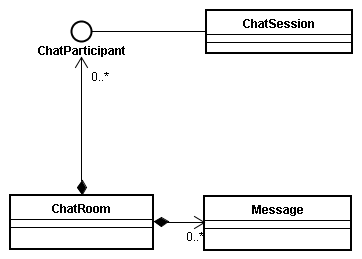C++单元测试一:并非看上去那么简单——几个很实际的问题
理想与现实
为Java和C#做单元测试,基本上都有比较统一的工具、模式可用,IDE的支持也非常到位;可是到了C++这里,一切就变的那样的“不走寻常路”,各种单元测试框架盛行,例如CppUnit, CppUnitLite, CxxUnit,Google Test等等,以及微软在VS2012中也加入了对原生C++代码单元测试的支持MSTest。面对如此诸多的测试框架,选择哪一个其实无所谓,只要顺手就好,用习惯了,什么都好;因为,单元测试的代码总归还是要自己来写——无论你用哪一个框架。
以前写过不少代码,可是都没怎么注意单元测试,现在终于认真对待起来,就开始在网络上搜寻资料,看看各种框架下的单元测试如何写。幸运的是,这方面的资料真不少,很多框架也都会带有示例或者文档告诉你怎么写;不幸的是,这些文档或者示例都太远离工程实践,他们一般遵循一个这样的模式:写出一个待测类CMyClass,定义一定的成员变量和方法,然后给出针对CMyClass的测试类如CMyClassTest;呵呵,看起来示例是够好了,可是很少涉及到这样的实际问题:
- 工程实践中,一个项目往往有很多类,而且相互之间,总有这或多或少的依赖、包含等关系;
- 实际的测试项目,该如何组织被测代码和测试代码(注意,这里所说的组织不是指单元测试数据如何组织,而是指工程中的测试代码和产品代码的组织)
- 被测代码如何引入测试工程中
- 一个测试工程如何测试多个被测类
实际的代码
好吧,我们来看一下一个“较为”实际的工程以及我在为该工程编写单元测试过程中所遇到的问题;该工程的代码来自于boost.asio中的一个示例代码:
http://www.boost.org/doc/libs/1_53_0/doc/html/boost_asio/example/chat/chat_server.cpp,
我把该cpp中的几个类分拆开了,放在一个VisualStudio 2012工程中,代码结构看起来是:
其中几个主要类Message,ChatSession,ChatRoom之间的关系如下图:
在我做单元测试过程中,首先从软柿子Message入手,然后为ChatRoom写UT。所以,先把这两个类的相关代码贴上来;其实贴不贴代码无关紧要,上面的类图已经可以说明问题,不过为了方便较真,还是贴出来吧。
Message类代码
/// Message.h
#pragma once
/// class represents the message transferred between the client and the server
/// the message consists of two part: header + message body
/// the header part, 4 bytes, stores the length of the message body
/// the max length of the message box is : 512
class Message
{
public:
enum { HeaderLength = 4, MaxBodyLength = 511 };
public:
Message(void);
~Message(void);
public:
void EncodeHeader();
bool DecodeHeader();
const char* Data() const;
char* Data() ;
const char* Body() const;
char* Body() ;
int SetData(const char* src, const int srclength);
int Length() const;
int BodyLength()const;
void Reset();
private:
void CheckBodyLength();
private:
/// stores the whole message
char Data_[HeaderLength + MaxBodyLength + 1];
/// the body length
int BodyLength_;
};
/// Message.cpp
#include "Message.h"
#include
#include
#include
#include "TraceLog.h"
Message::Message(void)
{
Reset();
}
Message::~Message(void)
{
}
void Message::CheckBodyLength()
{
BodyLength_ = BodyLength_ > MaxBodyLength ? MaxBodyLength : BodyLength_;
}
void Message::EncodeHeader()
{
/// Check the body length
CheckBodyLength();
/// wirte the body length to the message header
/// we make sure that the buffer is enough after we call CheckBodyLength()
::_snprintf_s( Data_, HeaderLength, HeaderLength, "%d", BodyLength_ );
}
bool Message::DecodeHeader()
{
int bodyLength = 0;
bool ret = false;
/// get the message body length from the message
try
{
char buf[HeaderLength + 1] = "";
std::strncat( buf, Data_, HeaderLength );
bodyLength = boost::lexical_cast (buf);
if( bodyLength > MaxBodyLength )
{
bodyLength = MaxBodyLength;
}
else
{
ret = true;
}
}
catch(boost::bad_lexical_cast& e)
{
/// cast error happens
bodyLength = 0;
TraceLog::WriteLine("Message::DecodeHeader(),error:%s, orinal message:%s", e.what(), Data_ );
}
/// set the value and return
BodyLength_ = bodyLength;
return ret;
}
char* Message::Data()
{
return Data_ ;
}
const char* Message::Data() const
{
return Data_ ;
}
char* Message::Body()
{
return Data_ + HeaderLength;
}
const char* Message::Body() const
{
return Data_ + HeaderLength;
}
int Message::SetData(const char* src, const int srclength)
{
/// check the length of source
int length = srclength;
if( length > MaxBodyLength )
{
length = MaxBodyLength;
}
/// copy the data into the local buffer
/// std::snprintf is unavailable in this c++ compiler
int ret = ::_snprintf_s(Data_+HeaderLength, MaxBodyLength + 1, length, "%s", src );
/// set the length of the message body
BodyLength_ = length;
/// return the length of copied
return ret;
}
int Message::Length() const
{
return BodyLength_ + HeaderLength;
}
int Message::BodyLength() const
{
return BodyLength_;
}
void Message::Reset()
{
BodyLength_ = 0;
/// just for using the lamda
std::for_each(Data_, Data_ + HeaderLength + MaxBodyLength + 1, [](char& p) { p = '\0'; } );
}
ChatRoom类代码
/// ChatRoom.h
#pragma once
#include "ChatSession.h"
#include "Message.h"
#include
#include
/// class that manages the clients
/// deliver the messages from one client to the others
class ChatRoom
{
public:
ChatRoom(void);
~ChatRoom(void);
public:
/// a client joins in the room
void Join(ChatParticipantPtr participant);
/// a client leaves the room
void leave(ChatParticipantPtr participant);
/// deliver the message from one client to all of the users in the room
void Deliver(const Message& msg);
private:
/// all of the participants are stored here
std::set Participants_;
/// recent messages
/// questions, how to synchronize this object in threads
typedef std::deque MessageQueue;
MessageQueue RecentMessages_;
enum { MaxRecentMsgs = 100 };
};
/// ChatRoom.cpp
#include "ChatRoom.h"
#include
#include
#include "TraceLog.h"
ChatRoom::ChatRoom(void)
{
}
ChatRoom::~ChatRoom(void)
{
}
/// a client joins in the room
void ChatRoom::Join(ChatParticipantPtr participant)
{
TraceLog::WriteLine("ChatRoom::Join(), a new user joins in");
/// add into the queue
Participants_.insert( participant );
/// sending the recent message to the client
std::for_each(RecentMessages_.begin(), RecentMessages_.end(),
boost::bind( &ChatParticipant::Deliver, participant, _1 ) );
}
/// a client leaves the room
void ChatRoom::leave(ChatParticipantPtr participant)
{
TraceLog::WriteLine("ChatRoom::leave(), a user leaves");
/// remove it from the queue
Participants_.erase( participant );
}
/// deliver the message from one client to all of the users in the room
void ChatRoom::Deliver(const Message& msg)
{
TraceLog::WriteLine("ChatRoom::Deliver(), %s", msg.Body() );
/// add the msg to queue
RecentMessages_.push_back( msg );
/// check the length
while( RecentMessages_.size() > MaxRecentMsgs )
{
RecentMessages_.pop_front();
}
/// deliver the msg to clients
std::for_each(Participants_.begin(), Participants_.end(),
boost::bind( &ChatParticipant::Deliver, _1, boost::ref(msg) ) );
}
开始单元测试
由于到手了VisualStudio 2012,这货已经原始支持了C++Native代码的单元测试,就用这货开始做UT吧。
如何引入被测代码
好了,我们开始单元测试。首先创建一个C++单元测试的工程,这个很easy。接着我们就要让测试工程能够“看到”被测的代码,这如何搞呢?有这样几种方法:
- 如果被测代码是静态库或者动态库,包含对应的.h文件,让测试工程链接DLL及LIB,这样测试工程。
- 或者,让测试工程链接对应的obj文件,直接编译进测试工程
- 或者,直接把被测是的代码,如上述的Message.h和Message.cpp包含进测试工程(注意这里不要拷贝一份Message.h和Message.cpp,用“Add->ExsitingItem”将他们包含进去,这样只保留一份代码)
- 或者在单元测试代码文件,如TestMessage.cpp中直接用#include把Message.h和Message.cpp包含进来,如:
#include "../ChatroomServer/ChatRoom.h"
#include "../ChatroomServer/ChatRoom.cpp"
上面这几种方法,其实原理都是一样的,反正就是让测试工程能够看到到被测的代码,我们使用把被测代码引入测试工程的方法,这样测试工程的代码结构看起来是这样:
Ok,现在在测试工程里面,可以看到Message类的声明和定义了,然后你的单元测试代码,该怎么写,就怎么写了。
一个测试工程只能测一个类吗?
使用VS2012中的单元测试框架,写完了对Message的的单元测试,在TestExplorer中RunAll,一切正常;好了,至此,一切还算顺利,那我们继续吧,来对ChatRoom类编写单元测试;
继续按照前面的方法,我们很容易让测试工程看到ChatRoom的被测代码;然而从ChatRoom的实现来看,这个类和Message类有着关联关系,而且在ChatRoom的方法中,也的确使用了Message类的方法,从单元测试的角度来看,我们应该将他们俩之间的关系隔断,从而保证我们只对ChatRoom进行测试,那这样,我们就需要Mock一份Message的实现。
可是问题来了,由于之前我们在测试Message类的时候,已经引入了Message.cpp文件,使得测试工程中,已经有了一份Message的实现,那么我们如何再能为Message提供一份“伪”实现呢??(使用其他几种引入方式,结果都是一样的)
是的,惯用的DependencyInjection在这里不起作用。查了不少资料,也没找到一个像样的说明如何解决这个问题;现在唯一可以采用的,就是在一个测试工程里面,只测试一个被测类,虽然可以工作,但是,未免又过于繁琐和“愚蠢”,那聪明的方法,又是什么呢?不瞒你说,这正是目前困扰我的问题之一。
追加一个后记:
其实,在关于如何为Message提供一份“伪”实现的问题上,原来想法是在测试工程中包含Message的头文件,然后在测试工程里面,直接写Message::Message()等方法,事实上是在测试工程里面定义一个Message的实现;这样由于我们已经引入了Message的真正实现,从而必然导致链接器报符号重复定义的错误,因此,这种思路并不可行,故而强迫我去创建另外一个工程;后来想一想,其实也不必真的去创建一个新工程,他们是可以在一个工程里面完成的,方法是新建一个MockMessage类,让他从Message继承下来,然后重新定义自己想Mock的方法就可以了。但是,这种方法创建出来的Mock,还是真的Mock吗,他首先已经是一个“真”的Message了啊?

